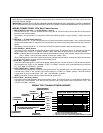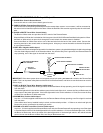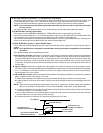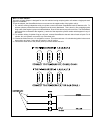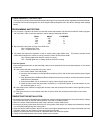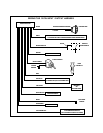
8. YELLOW w/ BLACK Tracer Wire: + 12 Volt Alarm By - Pass Output
This wire provides a 500 mA + 12 Volt transistorized output when the ignition key is turned to the “ON” position, and
0 Volts when the ignition key is “OFF” and when the vehicle is running under the control of the remote starter.
This wire should be connected to the ignition input of the alarm system (Yellow wire for Audiovox alarms).
NOTE: You must disconnect the ignition input of the alarm from any other wire that it is presently connected
to in the vehicle.
The Yellow w/ Black wire output will allow you to remote start the vehicle while leaving the alarm armed.
9. (2) WHITE Wires: Parking Light Flasher
These wires are the COMMON and NORMALLY OPEN contacts of the on-board parking lamp relay.
If the vehicle's parking lights are a +12 volt switched system, connect (1) of the White wires to a fused (at least 15A)
+12 volt battery source, and connect the second White wire to the vehicle's parking light wire.
If the vehicle's parking lights are a chassis ground switched system, connect (1) of the White wires to a chassis ground
source, and connect the second White wire to the vehicle's parking light wire.
10.LIGHT BLUE Wire: Ignition 3 / Shock Disable Output
This is a 500 mA transistorized ground output, and an external relay will be required in all cases that this output is
needed.
NOTE: This Light Blue wire is energized 3 seconds before starting and remains energized for 4 seconds after
shut down.
The Light Blue output serves the following functions.
A. Shock Sensor Override: If the alarm is connected to a shock sensor, then the vibration caused by remote starting
the vehicle may trip the alarm. If this is the case, connect the Light blue wire to terminal 86 of an external relay.
Connect terminal 85 of the relay to a fused + 12 Volt battery source. Cut the trigger wire from the shock sensor, and
connect one side of the cut wire to terminal 30 of the relay. Connect the other side of the cut wire to terminal 87a
of the relay. Just before the remote starter is activated, the relay contacts will open, and the shock sensor will not
trip the alarm.
B. Ignition 3 Output: Some newer vehicles use a third ignition wire, which is necessary to keep the engine running.
If thisis the case,connect the Light Bluewire to terminal86 of anexternal relay. Connect terminals85 and 30together
toa+12Volt battery source that is fused for a minimum 25 A rating. Connect terminal 87 of the external relay to
the third ignition wire in the vehicle.
C. G.M. VATS Key Override: If the vehicle has the General Motors VATS system installed, you will need to by-pass the
starter cut portion of the VATS system. To do this;
1. Measure the resistance of the ignition key, and get a resistor whose value is within 5% of the key value.
2. Locate the pair of VATS wires in the vehicle, usually running from the ignition switch to the passenger side of the
vehicle.
NOTE: These wires are typically White w/ Black tracer and Violet w/ Yellow tracer, however in late model Cadillacs,
they are run through an Orange sleeve, and are either both Black, both Yellow, or both White wires.
3. Connect the Light Blue wire from the Remote Starter to terminal 86 of an external relay. Connect terminal 85 of
the relay to a fused + 12 Volt battery source.
4. Cut (1) of the VATS wires, and connect the ignition switch side of the cut wire to terminal 87a of the relay. Connect
the other side of the cut wire to terminal 30 of the relay.
5. Connect the resistor from terminal 87 of the relay to the second VATS wire.
VATS WIRE #1 (CUT)
TOWARDS VATS MODULE
TO FUSED +12 VDC
BATTERY SOURCE
MATCHING RESISTOR
LIGHT BLUE IGN.3WIRE FROM
REMOTE START MODULE
VATS WIRE #1 (CUT)
TOWARDS IGNITION SWITCH
87
87a
85
86
30
VATS WIRE #2




